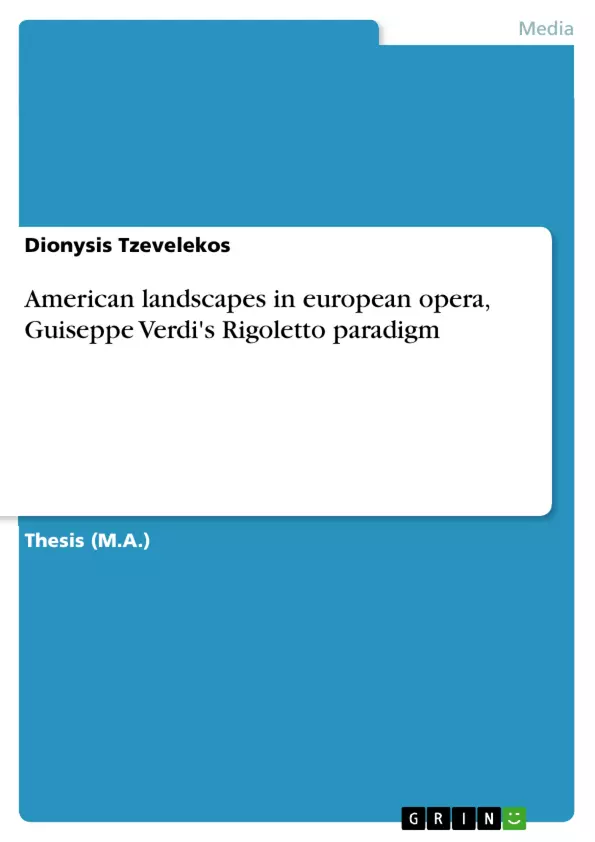The operatic genre is considered to be locked in a rigid itinerary, which cannot perform detours of any kind. Therefore, it is thought to be genre that is more revered than respected bearing, thus, a resemblance to religion rather than art. What this dissertation seeks to explore is a certain possibility in the form of a hypothesis. We will explore the “what-if” of unlocking this rigidity and attempting a sort of transfiguration. By painting the scenery, or rather the landscape of opera in colors of current American trends and traits. USA has always been a country which has had the privilege of nurturing opera fans by supporting the popularity of opera in a variety of ways. What will be examined are the ways that inspired directors Jonathan Miller and his 1975 “Mafia” production of Rigoletto for the ENO as well as James McDonald’s 2002 “White House” production of the opera for the WNO, to present the opera in an American context. Giuseppe Verdi’s masterpiece Rigoletto along with its manifestations and interpretations by these two directors that design and paint an American landscape for European either by provoking the audience and in particular, opera-buffs and hardcore fans, or by triggering images known and popular to the wider audience bestowing upon opera a most welcome sense and nuance of familiarity and belongingness. Rigoletto offers and carries the powerful potential to function as a canvas for this venture to be formulated. The opera’s characters, as viewed through the landscapes that these two directors have painted, invite the audience to familiarize themselves with figures that are flexible enough to unfold as space-less, deterritorialized images that have the ability to provoke and boast an Americaness which can be either welcome or cause a bit of an uncomfortable spine-tingling wonderment of political and cultural nature.
Inhaltsverzeichnis (Table of Contents)
- Acknowledgements
- Introduction
- Chapter One
- Chapter Two
- Chapter Three
- Conclusion
- Works Cited
Zielsetzung und Themenschwerpunkte (Objectives and Key Themes)
This dissertation investigates the potential for reimagining the operatic genre by applying contemporary American cultural trends and sensibilities to traditional European opera. Specifically, it analyzes how directors Jonathan Miller and James McDonald have used American settings and imagery to reinterpret Giuseppe Verdi's Rigoletto for contemporary audiences.
- The possibilities and limitations of genre transformation in opera
- The influence of American culture on European opera
- The role of directors in shaping audience perceptions and interpretations of opera
- The use of specific American settings and imagery (e.g., mafia, White House) in Rigoletto productions
- The potential for opera to resonate with a wider audience through contemporary cultural references.
Zusammenfassung der Kapitel (Chapter Summaries)
This section is not available as it includes content from the conclusion and final chapter which are considered spoilers.
Schlüsselwörter (Keywords)
The dissertation focuses on key themes and concepts such as America, Americaness, audience, canvas, censors, censorship, composer, Europe, European, familiarity, icons, images, imagery, interpretation, landscape, mafia, manifestation, relocation, renovation, text, textuality, and White House.
- Arbeit zitieren
- Dionysis Tzevelekos (Autor:in), 2008, American landscapes in european opera, Guiseppe Verdi's Rigoletto paradigm, München, GRIN Verlag, https://www.grin.com/document/263193



